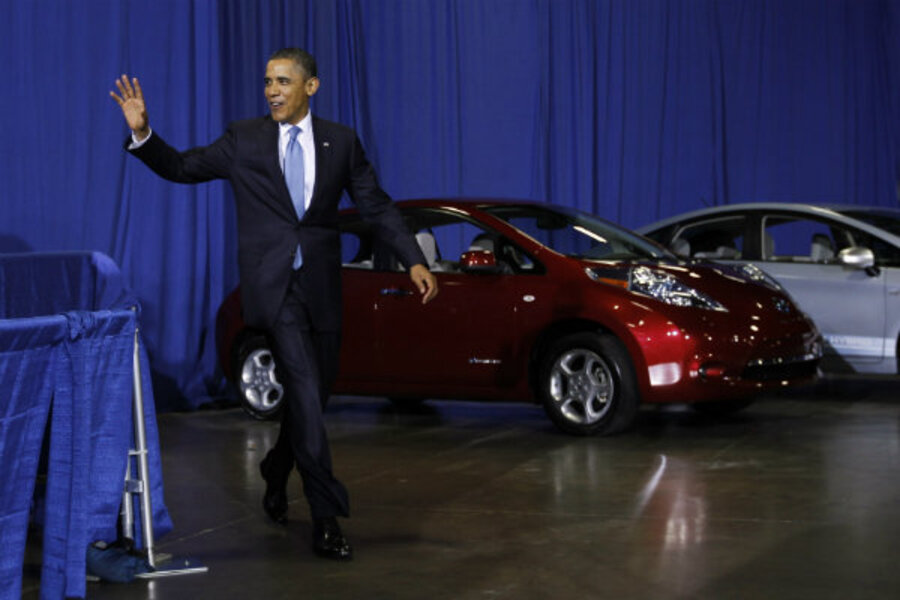Obama's meddling puts the brakes on the green car industry
Loading...
| Alexandria, Va.
Fearing an electoral backlash over rising gasoline prices, President Obama has been touting his energy policies. “We can’t have an energy strategy for the last century that traps us in the past,” the president said in a recent appearance. “We need an energy strategy for the future.”
Promising to save Americans money by having the federal government play a more active role in developing future energy-efficient vehicles, the president said of critics, “There always have been folks who are the naysayers and don’t believe in the future, and don’t believe in trying to do things differently.”
What’s strange about this futuristic talk is that Mr. Obama’s plan to boost vehicle efficiency relies heavily on decades-old policies that have repeatedly failed. Indeed, the fuel efficiency of the US automotive fleet, which grew rapidly throughout the 1970s and 1980s, slowed significantly after the federal government became an active “partner” in vehicle design.
Before 1993, the federal government took mostly a backseat role in automobile design. Then President Clinton created the Partnership for the Next Generation Vehicle, a joint venture between the federal government and major American car companies.
“Today we are going to...launch a technological adventure as ambitious as any our nation has ever attempted,” Mr. Clinton said in a Rose Garden ceremony. Vice President Gore added, “The public should expect breakthroughs that will redefine the automobile industry and position our companies to have an excellent chance to dominate the market for an entirely new kind of automobile.”
Throughout the 1990s the Clinton administration kept up the hype, promising that by 2004 Detroit would be supplying consumers with 80-mile-per-gallon, family-sized vehicles. Yet by the dawn of the new century it became clear that this was a pipe dream.
Even more embarrassing was the fact that Toyota and Honda, foreign firms that had been excluded from the partnership, began introducing hybrid cars to the American market with fuel efficiency levels that approached the targets set for Clinton's partnership program.
Failure in government, however, is often the ticket to an even larger policy role. In 2002, the Bush administration rebranded the partnership the FreedomCAR, pumped up its budget, and expanded its mission. The next year the program grew to include energy firms, and its budget ballooned even more.
In the 2003 State of the Union address President Bush proclaimed, “With a national commitment, our scientists and engineers will overcome obstacles to taking these cars from laboratory to showroom so that the first car driven by a child born today could be powered by hydrogen and be pollution-free.”
Again, however, actual program results bore little semblance to presidential rhetoric. Nevertheless, the program lives on today, again under a new name – US DRIVE.
In spite of this record of failure, the Obama administration has poured hundreds of millions into the so-called advanced vehicle and fuel industries and wants to increase involvement in the future. Unfortunately, the harm done by these handouts is likely to extend far beyond simply wasting taxpayers’ money.
The federal government has no expertise designing fuel-efficient vehicles. Nor does it have any unique insight as to which technologies will be successful in the future. What it does have is the ability to trade legislation favorable to its “partners” for campaign contributions and political support.
This unholy alliance between government and business could act as an impediment to innovation as insiders use their political clout to squash innovation by outsiders that threatens them. If people doubt this, they only need recall what happened to Japanese companies when they proved “too successful” at providing consumers with high-quality, technologically advanced and fuel-efficient cars in the 1980s: The US government slapped import restrictions on them at the behest of US automakers and their unions.
The perversion of public policy to serve private interests is hardly confined to the automobile industry. High prices and inefficiencies brought about by the so-called “capture” of federal agencies overseeing railroads, trucking, and airlines led to politicians with as diverse views as Ronald Reagan and Ted Kennedy championing deregulation of those sectors in the 1970s and 1980s.
The benefit to consumers of disentangling public and private interests has been enormous. The resulting drop in fares brought about by structural and technological innovation of the airline industry, for example, helped turn a mode of transportation once reserved for the “jet-set” into one for the masses.
The high-tech products that have added so much to our lives in recent years – smart phones, iPads, and the like – are not the result of public-private partnerships or federal subsidy programs. Instead they are the outcome of firms wrangling for consumers’ dollars in the marketplace. The federal foray into automotive engineering over the last two decades has clearly shown that such intervention is not a substitute for this process. Indeed it’s been a hindrance.
The key to developing the vehicles of tomorrow is to end government intervention in the automotive sector and allow firms to experiment with a wide range of technologies on an open, level playing field. Such a do-nothing policy would help our country progress in two important areas: developing more efficient, safer and smarter cars, and cleaning up Washington.
Patrick Fleenor is chief economist of Fiscal Economics, Inc.






